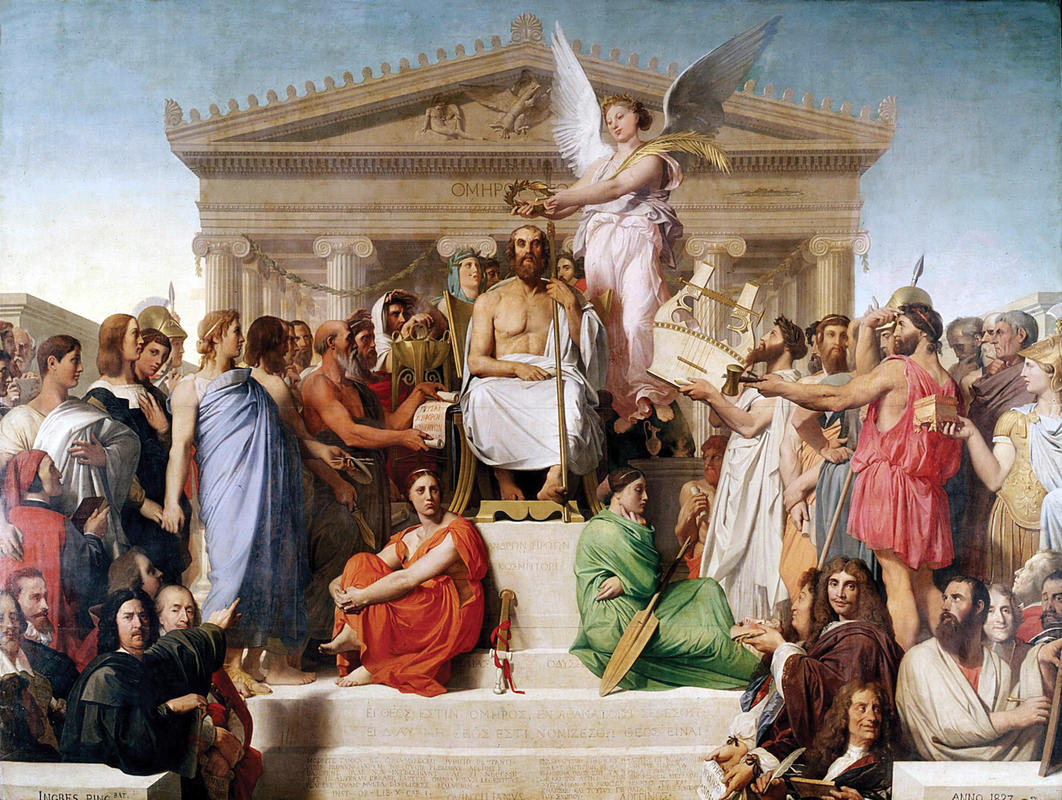More about The Apotheosis of Homer

Contributor
Jean-Auguste-Dominique Ingres’ The Apotheosis of Homer is the most lit group of artists, poets, and philosophers of all time.
Ingres was commissioned to make this piece as a ceiling decoration for the Musée Charles X, which is now the Egyptian Rooms of the Louvre. Despite all of the incredible detail that went into this work, it took only a year to complete. I’ve had dirty socks in my laundry for longer than that. It was rumored that Ingres got boils from the stress of making this artwork – Ingres was quite the perfectionist – but what’s a boil compared to the creation of a masterpiece? It’s a classic now, but this work didn’t go over well when Ingres presented it at the Salon in 1827. It was removed from the ceiling of the Louvre just under 30 years later in 1855. We can only imagine how Ingres, who was sensitive, egotistical, and arrogant, took this news. If only he could see how much we love and appreciate him now!
This painting was modeled after Raphael’s The School of Athens but does one step better by including famous literary and artistic figures. It depicts some of the most incredible figures in history and mythology. First and foremost is Homer, obviously, who is sitting in the middle being deified. Below him on the steps in the red and green togas are the representations of the "The Iliad" and "The Odyssey" respectively. The goddess crowning Homer is Nike, and dispersed amongst the crowd is Michelangelo, Raphael, Dante, Phidias, Poussin, Plato, Socrates, Aristotle, Virgil, Sophocles, Orpheus, Hesiod, Molière, William Shakespeare, Aesop, Alexander the Great, and even Ingres himself. It’s almost as if Ingres was asked the standard question, “who, alive or dead, would you want to have dinner with and why?” and just never stopped thinking about his answer until this painting came out.
Sources
- Harris, Dr. Beth and Dr. Steven Zucker. “Ingres, Apotheosis of Homer.” Accessed November 7, 2018. https://www.khanacademy.org/humanities/becoming-modern/romanticism/roma…
- “Homer Deified, also known as The Apotheosis of Homer.” The Louvre. Accessed November 11, 2018. https://www.louvre.fr/en/oeuvre-notices/homer-deified-also-known-apothe…
- Michael Kimmelman. “ART REVIEW; Ingres: An Icy Eye for People” last modified October 8, 1999. https://www.nytimes.com/1999/10/08/arts/art-review-ingres-an-icy-eye-fo…
- Russell, John. “ART REVIEW; Portraits of Intelligence, Recognizable in Any Era” last modified February 11, 2000. https://www.nytimes.com/2000/02/11/arts/art-review-portraits-of-intelli…
Featured Content
Here is what Wikipedia says about The Apotheosis of Homer (Ingres)
The Apotheosis of Homer is a grand 1827 painting by the French Neoclassical artist Jean-Auguste-Dominique Ingres, now exhibited at the Louvre as INV 5417. The symmetrical composition depicts Homer being crowned by a winged figure personifying Victory or the Universe. Forty-four additional figures pay homage to the poet in a kind of classical confession of faith.
Check out the full Wikipedia article about The Apotheosis of Homer (Ingres)












